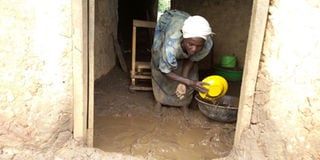Famine looms as floods ravage gardens in eastern region

Affected. Ms Teopista Kituyi, a resident of Bukashewa Village in Bunangaka Parish, Nabongo Sub-county, Bulambuli District, in her flooded house. PHOTO BY MICHEAL WONIALA
What you need to know:
- Ms Mary Gorreti KItutu, the State the Minister of Water and Environment. “I have warned about this before, the soils in Bugisu region have loosened because we have cut down trees that hold water. When it rains, water stagnates and sinks into the lower layers. After that it goes underground, and then starts oozing from underground.”
Ms Jessica Kituyi, 41, shakes her head in despair every time she wades through flood waters in her house.
“I have tried to empty the water from my house, it is two days now but all in vain. The house is muddy and everything is soaked,” Ms Kituyi, a mother of five, says.
Carrying her eight-month-old baby on her back, Ms Kituyi cautiously walks through her flooded house looking for a mingling stick as she prepares a meal for her children.
The visibly hungry children sit patiently outside in a mango tree shade.
“They are hungry and have not eaten anything for the day. We spent the night at our neighbour’s home after the floods submerged our house,” she says, pointing at a neighbour’s house, which is a few metres away.
Ms Kituyi is among the hundreds of families whose houses are still submerged by flood following the incessant rainfall since the weekend.
More than 100 houses have collapsed, while others have developed cracks, mostly in the sub-counties of Bulegeni, Bukhalu, Muyembe, Bunalwele, Bugwanyi and Nabongo in Bulambuli District.
Other affected sub-counties are Bwihoge, Bunabutye, Bumufuni, and Bulambuli and Buyanga town councils.
Gardens of maize, millet, groundnuts and vegetables have also been destroyed by floods. It is also estimated that about 200 families have been displaced, with latrines and bridges destroyed.
Mr Fred Smiti, a resident of Nabongo Sub-county, says they are worried because the water has continued to trickle from the underground inside their houses, which has not been the case previously when the floods occurred.
“Previously, the water used to dry up fast but now it is instead trickling from underground even after the rain has ceased,” he says.
Mr Wilson Mugole, the chairperson for Namulo Village in Butaleja District, says the floods have left them with nothing except their children and empty gardens.
“These are hard times for us because the floods washed away all crops in our gardens and even our household items including food,” he says.
The floods, which occurred last week in Butaleja and Tororo districts after River Manafwa and River Malaba burst their banks, have left one person dead. The deceased reportedly drowned in River Malaba.
The Bulambuli District chairperson, Mr Simon Peter Wonanzofu, says hunger is likely to strike as crops, and other food items have been destroyed.
“All crops have been destroyed and we project that famine is going to strike and it is likely to be worse because the scale of destruction is big,” he said.
He also expressed fears of possible outbreak of water-borne diseases as the downpour continues pounding the region.
Intervention
Mr Muhamed Mungoma, the Bulambuli District health officer, says with the help of village health teams they have distributed water tablets to the locals as a precautionary measure.
The heavy rainfall has been pounding the region since Friday last week, rendering most roads impassable.
The local leaders have asked government to provide the districts affected by floods with excavators so that they can dig drainage channels in order to draw water to nearby streams. This, they say, will prevent flooding.
The State Minister for Water and Environment, Ms Mary Gorreti Kitutu, explains that oozing of water from the underground is due to the soils loosening following massive deforestation.
“I have warned about this before, the soils in Bugis sub- region have loosened because we have cut down trees that hold water. When it rains, water stagnates and sinks into the lower layers. After that it goes underground, and then starts oozing from underground,” she said.
Last year, about 200 families were displaced in Namisindwa District following cracks in their houses and earth movements.
Mr Francis Alinyo, an environmental expert working with Mt Elgon Tree Growing Enterprise, says the flooding is an effect of climate change, which have been worsened by environmental degradation countrywide.
“These catastrophes are result of human activities such as deforestation, degradation of wetlands, poor farming methods, among others,” he says.
He adds that there is need to carry out interventions such as planting trees in order to curb the looming disasters.
However, Mr Robert Mauka, the Nabongo Sub-county chairperson, says they have tried to adapt but the floods seem not about to relent.
“Now look, several houses have been destroyed again and those displaced have nowhere to stay. Nothing to eat,” he says.
Mr James Ingoi, the Bulambuli Deputy Chief Administration Officer, says the situation is dire.
“The displaced people are now sheltering at churches, schools and mosques. They need support,” he said, adding that the government should intervene with relief items such as blankets, food, tents, among others.
“We have written to the Office of the Prime Minister about this tragedy because as a district, the problem is too big for us to handle,” he adds.
However, Mr Alex Burundo, the Member of Parliament for Bulambuli County, says there is need to find lasting solutions to the floods. “The government and development partners must unite and find solution to control floods, which have become a menance to our people,” he appeals.




